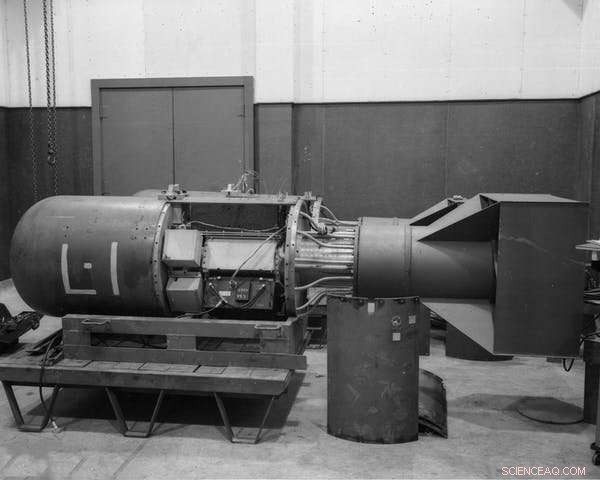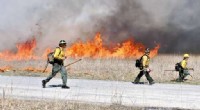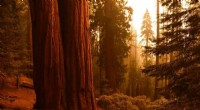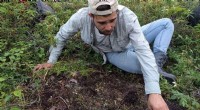Hvor længe er der til midnat? Dommedagsuret måler mere end nuklear risiko, og det er ved at blive nulstillet igen

Atombomben med kodenavnet 'Little Boy', den samme type blev senere kastet på Hiroshima ved Los Alamos National Laboratory i 1944. Kredit:Shutterstock
Om mindre end 24 timer vil Bulletin of the Atomic Scientists opdatere dommedagsuret. Det er i øjeblikket 100 sekunder fra midnat - det metaforiske tidspunkt, hvor menneskeheden kunne ødelægge verden med teknologier, den selv fremstillede.
Hænderne har aldrig før været så tæt på midnat. Der er et ringe håb om, at det vender tilbage på det, der bliver dets 75-års jubilæum.
Kom med os til meddelelsen om 75-års jubilæet Dommedagsur torsdag den 20. januar kl. 10:00 EST
Detaljer:https://t.co/UgE8wtUvND pic.twitter.com/RyWu91AnfP
— Bulletin of the Atomic Scientists (@BulletinAtomic) 9. januar 2022
Uret blev oprindeligt udtænkt som en måde at gøre opmærksom på nuklear brand. Men de videnskabsmænd, der grundlagde Bulletin i 1945, var mindre fokuserede på den indledende brug af "bomben" end på det irrationelle i at oplagre våben af hensyn til det nukleare hegemoni.
De indså, at flere bomber ikke øgede chancerne for at vinde en krig eller gjorde nogen sikker, når blot én bombe ville være nok til at ødelægge New York.
Mens nuklear udslettelse fortsat er den mest sandsynlige og akutte eksistentielle trussel mod menneskeheden, er det nu kun en af de potentielle katastrofer, dommedagsuret måler. Som Bulletin udtrykker det:"Uret er blevet en universelt anerkendt indikator for verdens sårbarhed over for katastrofer fra atomvåben, klimaændringer og forstyrrende teknologier på andre områder."
Flere forbundne trusler
På det personlige plan føler jeg en vis følelse af akademisk slægtskab med urmagerne. Mine mentorer, især Aaron Novick, og andre, som havde dybt indflydelse på, hvordan jeg ser min egen videnskabelige disciplin og tilgang til videnskab, var blandt dem, der dannede og sluttede sig til den tidlige Bulletin.
I 2022 strækker deres advarsel sig ud over masseødelæggelsesvåben til at omfatte andre teknologier, der koncentrerer potentielt eksistentielle farer – inklusive klimaændringer og dens grundlæggende årsager i overforbrug og ekstrem velstand.
Mange af disse trusler er allerede velkendte. For eksempel er kommerciel brug af kemikalier altomfattende, ligesom det giftige affald, det skaber. Der er titusindvis af store affaldspladser alene i USA, med 1.700 farlige "superfundspladser" prioriteret til oprydning.
Som orkanen Harvey viste, da den ramte Houston-området i 2017, er disse steder ekstremt sårbare. An estimated two million kilograms of airborne contaminants above regulatory limits were released, 14 toxic waste sites were flooded or damaged, and dioxins were found in a major river at levels over 200 times higher than recommended maximum concentrations.
That was just one major metropolitan area. With increasing storm severity due to climate change, the risks to toxic waste sites grow.
At the same time, the Bulletin has increasingly turned its attention to the rise of artificial intelligence, autonomous weaponry, and mechanical and biological robotics.
The movie clichés of cyborgs and "killer robots" tend to disguise the true risks. For example, gene drives are an early example of biological robotics already in development. Genome editing tools are used to create gene drive systems that spread through normal pathways of reproduction but are designed to destroy other genes or offspring of a particular sex.
Climate change and affluence
As well as being an existential threat in its own right, climate change is connected to the risks posed by these other technologies.
Both genetically engineered viruses and gene drives, for example, are being developed to stop the spread of infectious diseases carried by mosquitoes, whose habitats spread on a warming planet.
Once released, however, such biological "robots" may evolve capabilities beyond our ability to control them. Even a few misadventures that reduce biodiversity could provoke social collapse and conflict.
Similarly, it's possible to imagine the effects of climate change causing concentrated chemical waste to escape confinement. Meanwhile, highly dispersed toxic chemicals can be concentrated by storms, picked up by floodwaters and distributed into rivers and estuaries.
The result could be the despoiling of agricultural land and fresh water sources, displacing populations and creating "chemical refugees."
Resetting the clock
Given that the Doomsday Clock has been ticking for 75 years, with myriad other environmental warnings from scientists in that time, what of humanity's ability to imagine and strive for a different future?
Part of the problem lies in the role of science itself. While it helps us understand the risks of technological progress, it also drives that process in the first place. And scientists are people, too—part of the same cultural and political processes that influence everyone.
J. Robert Oppenheimer—the "father of the atomic bomb"—described this vulnerability of scientists to manipulation, and to their own naivete, ambition and greed, in 1947:"In some sort of crude sense which no vulgarity, no humor, no overstatement can quite extinguish, the physicists have known sin; and this is a knowledge which they cannot lose."
If the bomb was how physicists came to know sin, then perhaps those other existential threats that are the product of our addiction to technology and consumption are how others come to know it, too.
Ultimately, the interrelated nature of these threats is what the Doomsday Clock exists to remind us of.
Sidste artikelHvad er en modstandsdygtig skov overhovedet?
Næste artikelTager Vesuv på en forlænget siesta?
 Varme artikler
Varme artikler
-
 Regnskov Vejr og klimaBåde ækvator- og mellemfladeregioner indeholder regnskove, og regnskovvejr og klima varierer efter geografi. De to primære typer regnskove er tropiske og tempererede. En tredje type, den tropiske m
Regnskov Vejr og klimaBåde ækvator- og mellemfladeregioner indeholder regnskove, og regnskovvejr og klima varierer efter geografi. De to primære typer regnskove er tropiske og tempererede. En tredje type, den tropiske m -
 Eksperter søger måder at øge overlevelsesraten for ekstreme naturbrandeI denne 8. marts, 2018 filbillede, Nationalparkens brandmænd begynder at løbe for at holde sig foran en kontrolleret forbrænding nær Abrahms Fall-stihovedet i Cades Cove i Great Smoky Mountains Nation
Eksperter søger måder at øge overlevelsesraten for ekstreme naturbrandeI denne 8. marts, 2018 filbillede, Nationalparkens brandmænd begynder at løbe for at holde sig foran en kontrolleret forbrænding nær Abrahms Fall-stihovedet i Cades Cove i Great Smoky Mountains Nation -
 Brandmænd kæmper for at beskytte kæmpe sequoias i Californiens brandeGiant sequoia træer er de største træer i verden, men er stadig sårbare over for de skrækkelige naturbrande, der raser gennem Californien. Hundredvis af brandmænd kæmpede for at beskytte flere lun
Brandmænd kæmper for at beskytte kæmpe sequoias i Californiens brandeGiant sequoia træer er de største træer i verden, men er stadig sårbare over for de skrækkelige naturbrande, der raser gennem Californien. Hundredvis af brandmænd kæmpede for at beskytte flere lun -
 skovbrande, skovning påvirker svampe fyrreskove er afhængige af for at overleve, undersøgelser vi…Ph.d.-kandidat Jean Rodriguez Ramos udfører feltforskning i svampe i jorden i en lodgepole fyrreskov. Ramos fandt ud af, at forstyrrelser såsom tørke, skovbrande og skovhugst ændrer balancen mellem sv
skovbrande, skovning påvirker svampe fyrreskove er afhængige af for at overleve, undersøgelser vi…Ph.d.-kandidat Jean Rodriguez Ramos udfører feltforskning i svampe i jorden i en lodgepole fyrreskov. Ramos fandt ud af, at forstyrrelser såsom tørke, skovbrande og skovhugst ændrer balancen mellem sv
- Nye sensorer kunne muliggøre smartere tekstiler
- Hvorfor lyst, fattige elever formår ikke at opnå topkarakterer
- Hvordan afskærer de flyvemaskiner?
- Russias RT ryger efter Facebook blokerer vildt populær side
- Tab af arktisk havis sætter gang i sommerens hedebølger i det sydlige USA.
- Gør elektronik ud af kul


